THE GOOD AND THE BAD OF A DRY AUTUMN
/3 Comments/in Fruit, Gardening, Vegetables/by Lee ReichJust Like Korea?
The bone dry weather blanketing the Hudson Valley and much of northeastern U.S. does have its saving graces. For one thing, it forces perennial plants to shut down and direct their energies to toughening up for cold weather lurking over the horizon. That’s a good thing — unless, of course, the soil gets dry enough to kill a plant. Deciduous plants have the option, before that happens, to drop their leaves, drastically reducing their water loss and needs.
This dry autumn weather is not unlike that in many parts of Korea. So what? When it comes to cold-hardiness, some plants that survive Korea’s frigid winters typically are done in by our similarly frigid winters. One plant that comes to mind is Asian persimmon (Diospyros kaki). The chances of an Asian persimmon surviving a winter here at my Zone 5 farmden and ripening its fruits are generally not good. Autumn weather like this year’s ups the odds.
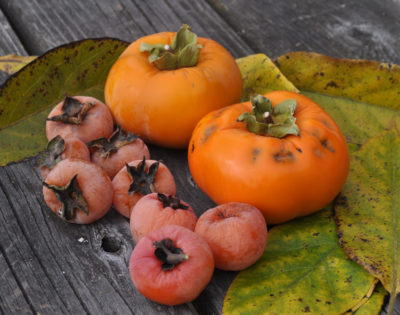
Asian & American persimmon, compared
(American persimmons (D. virginiana), on the other hand, easily survive, and varieties such as Szukis and Mohler reliably ripen their fruits here.)
Survival of an Asian persimmon here is very topical to me because I planted one this past spring. I did plant one of the most cold-hardy varieties, Great Wall. This variety is allegedly hardy and will ripen fruit in Zone 5 (at least that’s what Lee Reich wrote in the book Uncommon Fruits for every Garden). This autumn weather should help get it through its first winter here.
Autumn Color Chemistry
This bone dry weather has also made for glorious autumn leaf colors, even more than usual. Did I write, last year, that autumn color was the best ever, and the year before that, and . . . ? The reason for the exquisite color is physiological (the leaves’, not mine).
Leaves can, of course, be green. Other colors also figure in, obscured by the green of chlorophyll until autumn’s cooler weather and shorter days dissolve away the chlorophyll to let these other colors strut their stuff. Autumn’s fiery oranges and yellows, especially prominent in sugar maple, gingko, aspen, hickory, and beech, are from carotenoids. Tannins are another color component that get expressed in autumn; they give oaks their brown color, and enrich the yellow hues of beeches and hickories.
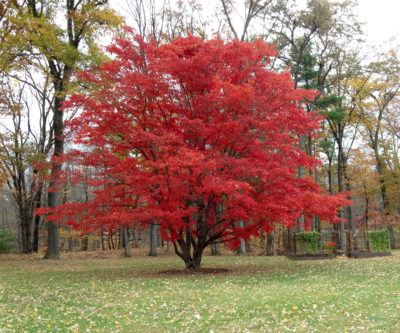
Japanese maple in autumn
Unless an early freeze burns off trees’ leaves while they are still green, those oranges and yellows and browns put on a reliable show every autumn, no matter what the weather.
Not so for the reds and purples of autumn leaves. These colors are expressed by anthocyanins, compounds which are not present or obscured by the green of chlorophyll during the growing season. Anthocyanins develop in autumn, and they need sugars for their development. Sugars come from photosynthesis, whose driving energy is sunlight.
So, less rain and more sunny weather means more photosynthesis, more sugars, and better red and purple color in such plants as blueberry, sourwood, scarlet oak, and sugar maple. A recent spate of warm days and cool nights enhances the whole effect, the warm days spurring photosynthesis and the cool nights slowing respiration to slow “burning” of sugars.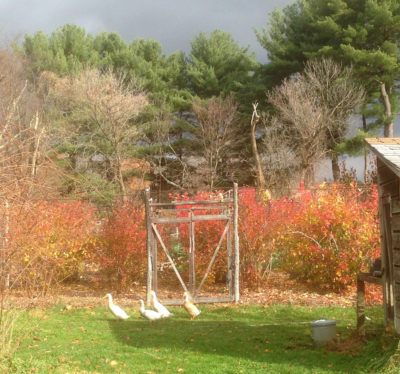
But How About Some Rain?
Much as I revel in day after day of clear, sunny weather and trees alive in color, I’d like a few heavy rains. The water supply of many homes on my road tap into shallow groundwater, the level of which is very low at this point.
Also, my drip irrigation system has been disconnected. The timer, the pressure reducer, and the filter, all of which must greet water as it comes out the spigot, before it enters the main lines, have been brought indoors to be protected from the recent freezing temperatures.
With reduced transpiration from cooler weather, autumn’s usual rainfalls can carry winter radishes, endive, Chinese cabbage, and other cool weather vegetables on a few more weeks until the end of the season. But we need these usual rains.
NUTTY TIMES AND COLD WEATHER
/9 Comments/in Flowers, Fruit, Gardening, Houseplants, Planning, Vegetables/by Lee ReichNuts Galore
What a nutty time of year, literally! Chestnuts and black walnuts, two of my favorite nuts, were raining down, figuratively, just before the middle of the month.
Black walnuts are free for the taking. Wild trees are everywhere around here, and keep increasing because of overlooked nuts buried by squirrels. The nuts are so abundant this year, and most years, that squirrels and humans can have their fill. (Not so with my filbert nuts; squirrels will strip those bushes clean.)
Black walnuts have a strong flavor. Like dark beer, fresh blackcurrants, and okra, not everyone likes the flavor. That’s fine. Fast food chains might purvey foods that everyone sort of likes, while a home gardener and gatherer can grow and gather fruits and vegetable and nuts that he or she really, really likes, and ignore what he or she really, really does not like.
There’s also, if you’re not a squirrel, the getting-to-the-nut problem with black walnuts. The first step is to remove it, as soon as possible after gathering the soft, messy, dark-staining husk. My wife, Deb, does this; I try and come up with contraptions to ease the job of husking 10 five-gallon buckets worth of nuts that eventually transmutes to 8 one-quart mason jars filled with nutmeats.
We’ve gone through a few incarnations of huskers. One year I bought an old fashioned corn husker, which needed some modification with an angle grinder. It didn’t do the job. Another year I ran the tractor back and forth over the nuts in the driveway, a common method, but not effective enough.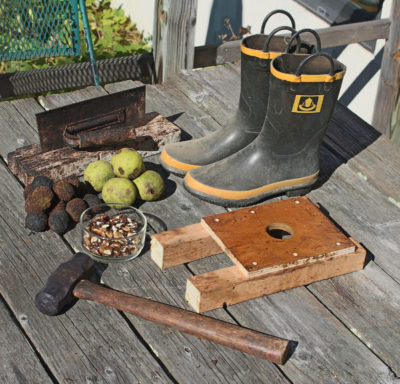
In years past, Deb has given each nut a tap with a light sledge hammer, which is enough to loosen the husk so it can be easily twisted off. Another year, I mounted a flat piece of metal in a slot I cut in a short length of 2-by-4 wood. Rolling the nut over the metal edge was enough to make the husk easy to twist off.
This year I drilled a nut-sized hole in a piece of wood and mounted it over a bucket. One whack with a light sledge hammer drove the nut through, minus the husk. Or, it was supposed to do that. One piece of husk, on the leading edge, alway stayed attached to the nut.
So now Deb is back to one of the standard methods for de-husking black walnuts: Stomp on them with your heel, then pick them off to rub off any remaining husk.
Readying for Cold Weather
Enough with the nuts . . . tonight (October 10th) temperatures are predicted to be in the low 30s, which means the high 20s in this cold spot. Mostly, I and the garden are ready for cold. Still to be done are:
•Close all hose spigots and open ends of drip emitters and main lines, watering wands, and hose sprayers to prevent the expansion of freezing water water from causing damage;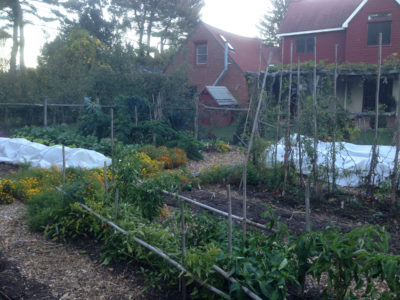
•Set up hoops and either clear plastic or row covers over beds of lettuce, Chinese cabbage, endive, arugula, and mustard greens. These vegetables tolerate temperatures well into the 20s, but I’ll cover them just in case. And they’ll anyway need the protective coverings soon;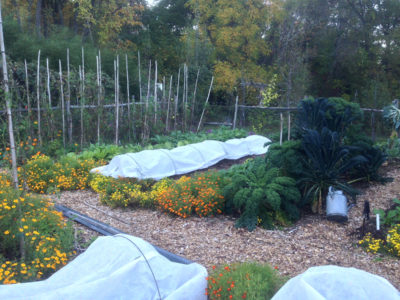
•Bring tropical plants indoors. Banana “trees,” staghorn fern, avocado, and clivia have laughed off cold so far, but tomorrow morning would not look so cheery if left outdoors. They get bright windows. A banana’s growing point is below ground which allows some gardeners to merely lop the whole top off the plant and store the bulb, in its pot, through winter under cool, dark conditions;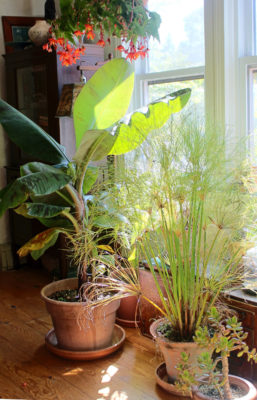
•Subtropical plants could survive temperatures into the 20s. I’m hoping for a crop from Golden Nugget mandarin, Meyer lemon, and Meiwa kumquat, so they’ve been walked indoors and perched near the most sun-washed windows in my house.
•Feijoa, olive, and Chilean guava are, like citrus, evergreen, subtropical plants, except they can tolerate colder temperatures than citrus. They sport neither fruits, flowers, nor flower buds now, so will remain outdoors until temperatures dip into the low 20s. Potted rosemary is also in this category; because I will be visiting it many times over the months that follow to clip off sprigs clipped for pizza and salad dressing, it’s new home is a sunny kitchen window.
•Basil will be dead tomorrow. Leafy stems picked today, their bottoms plunked into a glass of water, will provide fresh basil for a few weeks. Then it’s on to frozen basil pesto.
Cold Weather Takes a Rain Check, Without the Rain
The Morning After: No drama. That’s the way I like it. The slider on my min-max thermometer registered a low of 29° last night. A far cry from my first gardens, in Wisconsin, where it seemed every year (for the five I gardened there) around September 21st I would be wake to a frigid morning and a garden of blackened tomato, marigold, and pepper plants. This morning, marigolds and peppers have felt the chill, but live on to die slowly day by day as the sun dips lower in the sky and temperatures creep lower and lower.
DUCKS AND TOMATOES
/14 Comments/in Fruit, Gardening, Planning, Vegetables/by Lee ReichMy Discerning Ducks
Every morning when I throw open the door to my Duckingham Palace (a name coined by vegetable farmer Elliot Coleman, for his duck house), my four ducks step out, lower their heads as if to reduce air resistance, and race to the persimmon tree. They trace a large circle around the base of the tree, scooping up any fallen persimmons and, still running, gulping them down quickly enough so no other member of the brood snatches it.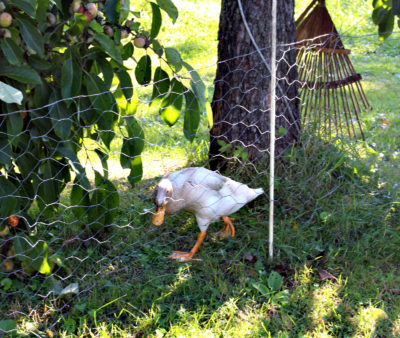
The circle is wide because of the low, temporary fence I’ve set up around the tree. Within the fenced area, I gather up most of the fallen fruit for myself. The ducks, can’t, or haven’t figured out how to, fly over an 18 inch high fence.
My tree is an American persimmon (Diospyros virginiana), native to eastern U.S. from Florida to northern Pennsylvania. Until they are dead ripe, most American persimmons taste awful, with an astringency that dries out your mouth. (As Captain John Smith, of Pocahontas fame, wrote, “When a persimmon is not ripe, it will draw a man’s mouth awrie with much torment.”) Some persimmons never lose that astringency, even when ripe, and here, in the northern reaches of persimmon growing, the season isn’t long enough to ripen most persimmons.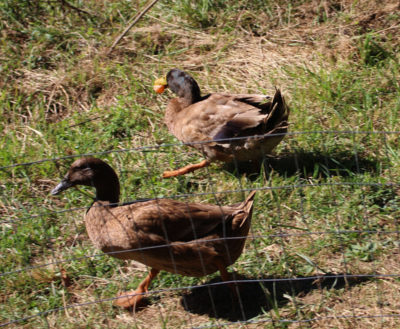
But good persimmons, when ripe, taste like dried apricots that have been soaked in water, dipped in honey, and given a dash of spice. Mine are selected varieties that ripen this far north, the first, Mohler, beginning in early September, and the second, Szukis, beginning in early October. (I grafted both varieties on one tree.) They also set fruit without the need for the separate male pollinator that most American persimmons require.
I highly recommend planting an American persimmon tree. Besides bearing delicious fruit, the tree is attractive all season long and shows off its pretty bark in winter. All this, without the need for spraying or pruning. (I wrote about American persimmon in my book Uncommon Fruits for Every Garden.)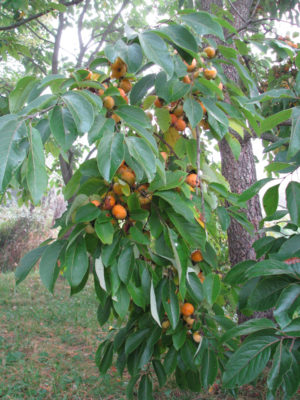
And the Winning Tomatoes Are . . .
As of this writing, tomato plants have not been killed by cold. But with cool weather and disease, they’re pretty much done for the season, bearing few or no fruits. That is, except for Sungold, the most tasty variety of cherry tomato. It just keeps pumping out ropes of orange fruits.
I grew over 20 varieties of tomatoes this year, all heirlooms, except for Sungold. My main criterion for planting any variety is flavor, which was very similar for certain varieties of tomato. They did differ in productivity, my second criterion for choosing a variety. So next year I plan to pare down the number of varieties I grow to the best tasting, most productive ones.
Topping that list will be San Marzano. Right off the plant, eating one is like eating bland cotton. Thrown into pot with a little water to prevent burning and simmered till soft, and the flavor morphs to tart, tomato-y richness. No wonder, canned San Marzano tomatoes are labeled as such in Italy.
Moving on to fresh eating tomatoes . . . Sungold, of course, with eight plants supplying enough for grazing outdoors and salads indoors. Anna Russian, Paul Robeson, and Red Brandywine all have excellent flavor and bore well and late into the season. Anna Russian is also quite good for paste.
Carmello and Valencia are good-tasting tomatoes, although not as good as Anna Russian and company. I’ll grow these two because they’re also very productive, and their fruits are almost perfect spheres. Many heirloom fruits are interesting for their convoluted shapes but sometimes I want just a standard issue, round tomato (that also tastes good).
One more possible variety is from seed a reader sent me a few years ago, a variety labeled Winterkeeper. The fruits allegedly store very well. The plants are still growing well; soon I’ll see how long into fall I’ll be eating tomato sandwiches. Ones I’ve already sampled have pretty good flavor.
Persistent, Young, and Vigorous
Every time I walk back to the compost bin and see the volunteer tomato vine insinuating itself out of a gap in the slats of the bin, I’m reminded of the importance of crop rotation. This vine is still lush and green, and laden with perfect, red, pear-shaped tomatoes.
Sure, the vine could be healthy because its roots are running through the rich, brown compost within the bin. Perhaps the vine is so healthy because, as a random seedling, its genetics, by lucky chance, makes it so.
Most likely, this plant is so healthy and productive because it’s growing where no tomato has grown before. No disease spores linger there from previous crops of tomatoes. (The plant got a late start for the season, so its youthful vigor could also have a hand in its health.) 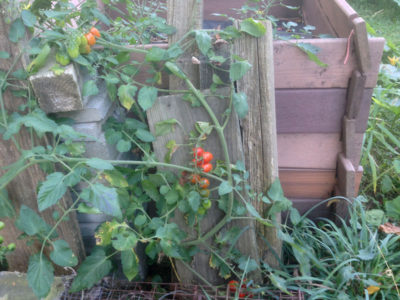
I rotate my tomato beds every year, but that only puts them 10 feet or so from beds of the previous year. That’s the problem with home gardens; it’s hard to get plants far enough away from where they recently were. Thorough cleanup and mulching help, but go only so far.
I have the luxury of two vegetable gardens separated by 50 feet of lawn, one of which hasn’t been home to tomatoes for over a year. Next year it will be.
The flavor of the compost-grown tomato? Good enough, not great.

